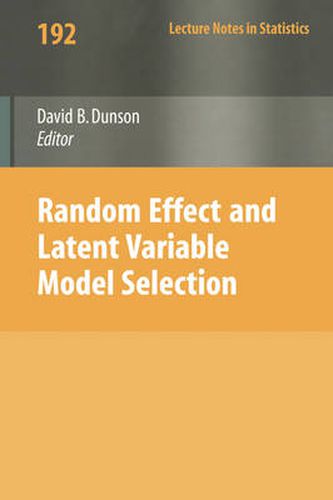Readings Newsletter
Become a Readings Member to make your shopping experience even easier.
Sign in or sign up for free!
You’re not far away from qualifying for FREE standard shipping within Australia
You’ve qualified for FREE standard shipping within Australia
The cart is loading…






This title is printed to order. This book may have been self-published. If so, we cannot guarantee the quality of the content. In the main most books will have gone through the editing process however some may not. We therefore suggest that you be aware of this before ordering this book. If in doubt check either the author or publisher’s details as we are unable to accept any returns unless they are faulty. Please contact us if you have any questions.
Random Effect and Latent Variable Model Selection In recent years, there has been a dramatic increase in the collection of multivariate and correlated data in a wide variety of ?elds. For example, it is now standard pr- tice to routinely collect many response variables on each individual in a study. The different variables may correspond to repeated measurements over time, to a battery of surrogates for one or more latent traits, or to multiple types of outcomes having an unknown dependence structure. Hierarchical models that incorporate subje- speci?c parameters are one of the most widely-used tools for analyzing multivariate and correlated data. Such subject-speci?c parameters are commonly referred to as random effects, latent variables or frailties. There are two modeling frameworks that have been particularly widely used as hierarchical generalizations of linear regression models. The ?rst is the linear mixed effects model (Laird and Ware , 1982) and the second is the structural equation model (Bollen , 1989). Linear mixed effects (LME) models extend linear regr- sion to incorporate two components, with the ?rst corresponding to ?xed effects describing the impact of predictors on the mean and the second to random effects characterizing the impact on the covariance. LMEs have also been increasingly used for function estimation. In implementing LME analyses, model selection problems are unavoidable. For example, there may be interest in comparing models with and without a predictor in the ?xed and/or random effects component.
$9.00 standard shipping within Australia
FREE standard shipping within Australia for orders over $100.00
Express & International shipping calculated at checkout
This title is printed to order. This book may have been self-published. If so, we cannot guarantee the quality of the content. In the main most books will have gone through the editing process however some may not. We therefore suggest that you be aware of this before ordering this book. If in doubt check either the author or publisher’s details as we are unable to accept any returns unless they are faulty. Please contact us if you have any questions.
Random Effect and Latent Variable Model Selection In recent years, there has been a dramatic increase in the collection of multivariate and correlated data in a wide variety of ?elds. For example, it is now standard pr- tice to routinely collect many response variables on each individual in a study. The different variables may correspond to repeated measurements over time, to a battery of surrogates for one or more latent traits, or to multiple types of outcomes having an unknown dependence structure. Hierarchical models that incorporate subje- speci?c parameters are one of the most widely-used tools for analyzing multivariate and correlated data. Such subject-speci?c parameters are commonly referred to as random effects, latent variables or frailties. There are two modeling frameworks that have been particularly widely used as hierarchical generalizations of linear regression models. The ?rst is the linear mixed effects model (Laird and Ware , 1982) and the second is the structural equation model (Bollen , 1989). Linear mixed effects (LME) models extend linear regr- sion to incorporate two components, with the ?rst corresponding to ?xed effects describing the impact of predictors on the mean and the second to random effects characterizing the impact on the covariance. LMEs have also been increasingly used for function estimation. In implementing LME analyses, model selection problems are unavoidable. For example, there may be interest in comparing models with and without a predictor in the ?xed and/or random effects component.